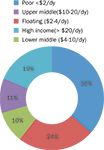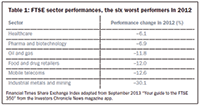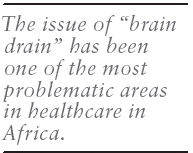Africa: The Lost Continent No More
Driven by a rising GDP and calmer political and financial waters over the past decade, Africa's nascent healthcare sector is poised for a fresh surge in growth.
Even though Africa boasts a fifth of the world's population, it only accounts for 3% of the world's foreign direct investment (FDI). Corrupt governments, the legacies of colonization, coup d'états, civil wars, bad governance and unfortunate natural disasters have all conspired to hinder Africa's growth, whilst the rest of the world marched on.

(PHOTO: THINKSTOCK)
But in the last decade, things suddenly began to change. Improved governance, better market-friendly policies, the decline of civil wars, as well as the establishment of democracy began to yield accelerating economic stability and growth.
In telecommunications, Africa has more people connected to a mobile network than the whole of Europe; economic growth, though not quite the 7% needed to achieve the Millennium Development Goals (MDGs) set by the World Health Organization in 2000, was relatively close at 5–6% in the last decade, according to a report by the Commission for Africa in 2010.
According to the World Bank, 60 million Africans earn over $3,000 per year, a figure set to reach 100 million by 2015. The consumption of Africa's households has grown by $275 billion in the last decade, similar to Brazil, and higher than India (see Figure 1).

Figure 1: Distribution of the African population by income (including remittances)
The February 2013 edition of the African Business newsmagazine stated that if current growth continues, by 2050 roughly 300 million Nigerians will enjoy an average income of $10,000 with a GDP of $3 trillion, similar to Germany today.
Africa's economic output has almost tripled in the last ten years; more wealth has been created in Africa in the last decade than any other time in its history, writes Evelyn Mhango, an economist in the "Fastest Billion."
The reasons for this explosive growth are manifold:
» Improved government policies have increased the scope for the private sector to grow, and have created the low-debt, low-inflation, much improved macro-conditions that have enabled this growth.
» According to Ernst & Young's (EY) African Attractiveness Survey, the strengthening of regulatory and legal systems, privatization of public enterprises and the opening up of economies to international trade have led to the quintupling of exports, record inflows of FDI and a doubling of per capita GDP.
» Increased democracy and the sharp decline of civil wars.
» David Mataen's book, Africa, the Ultimate Frontier Market, lists eight megatrends that have driven Africa's current and future economic realities: population growth and demographic shifts; cultural revolutions; rapid urbanization; commercialization of essential services such as healthcare; deregulation and liberalization; growth of credit; capital market development; and consolidation and evolution of intra-African markets.
» The recent debt relief through the IMF/World Bank Highly Indebted Poor Countries Initiative (HIPC) have enabled African countries to divert much-needed funds earmarked for debt repayments into health, education and infrastructure.
According to TIME magazine (December 3, 2012), business increasingly dominates foreign investment in Africa. Investment first outpaced aid in 2006, and now doubles it. This growth was, contrary to popular belief, spread across various sectors.
Healthcare problems
Healthcare outcomes in sub-Saharan Africa remain the worst in the world. Even though its population is around 11% of the world's total, it bears a quarter of the global disease burden; less than 1% of the global health expenditure is spent here, and it has just 3% of the world's health professionals.
Infectious and parasitic diseases form the bulk (42.4%) of the disease burden in Africa, but this is rapidly being compounded by the sharp rise of NCDs, particularly diabetes, chronic respiratory diseases, cancers and cardiovascular diseases.
A major problem is the sorry state of the majority of Africa's public health systems. Billions of aid spent on improving Africa's health systems has yielded poor results. Health systems are grossly understaffed, have crumbling and decaying infrastructure and are short on medical supplies. In addition, being built, equipped and trained to handle mainly parasitic and infectious diseases, Africa's health systems are ill-prepared for this extra epidemic of NCDs.

Mark Swai, former hospital director of the Kilimanjaro Christian Medical Centre, talking to Pharm Exec in 2013, said "the beds of our new HIV/AIDS were filled with HIV patients whose diseases were not under control. Since the introduction of affordable anti-retroviral drugs that decreased the disease burden, those beds are now filled with diabetes patients."
Due to these chronic problems, most Africans flock to the private sector, not through choice but because in most cases, it remains the only option.
But the private sector is also bedevilled with its own serious issues; poor managerial competency and regulatory oversight mean that prices for essential drugs cost hundreds more than the trade costs, services are poor, staff are badly trained with questionable ethics, the sector is plagued with excessive fragmentation, and medicines are either poor quality, expired or counterfeited.
Opportunities for growth
The problems listed above, though posing huge issues, point to a low-hanging-fruit market that is ripe for innovative disruption and presents huge opportunities.
Faster economic growth signals that the healthcare market is sure to grow; the International Finance Corporation estimates that the pharmaceutical market will expand to $35 billion by 2016, and $40 billion in 2020, surpassing the UK. Spending on healthcare has increased by a compound annual growth rate of 9.6% since 2000. This demand for better healthcare presents several different bankable opportunities (see Figure 2).

Figure 2: Breakdown of private health investment opportunities in sub-Saharan Africa, 2007-2016 %, $ million (11,300-20,300)
The IFC estimates that $25-30 billion in new investments will be needed to meet the demand for medical care between now and 2016, of which up to 40% is expected to come from the private sector; Robertson, writing in The Fastest Billion, expects a real increase of 72% in health expenditure through 2020.
Investing in healthcare also makes financial sense; in stark contrast to the 9.6% CAGR in the African healthcare sector from 2000, the healthcare, drug retailing, and pharmaceutical market growth were all in the six-worst performing sectors in the Financial Times Share Exchange (FTSE) 350 in 2012 (see Table 1).

Table 1: FTSE sector performances, the six worst performers in 2012
However, private investment into the healthcare sector in Africa has been strikingly low:
» EY's African Attractiveness survey revealed that, of the $587 billion of FDI that Africa attracted in 2011, only 1% went to healthcare projects.
» In one of McKinsey's often-quoted studies on Africa, "Lions on the Move (2010)," healthcare is not in the top 12 sectors for attracting investment.
» According to an EY study, of private equity in Africa, healthcare accounted for only 5% of exits by sector; even though 70% of FDI was in the services sector, healthcare did not even make the top ten.
» In the three best-selling books, Africa Rising (2008), Africa, the Ultimate Frontier Market (2012), and The Fastest Billion (2012), healthcare does not feature in the listings of the sectors most attractive for investment.
The five determinants of FDI in healthcare in sub-Saharan Africa
1. The question of affordability. According to Vijay Mahajan's Africa Rising (2009), the low-hanging fruit—or the elite (Africa One)—is the target of most private for-profit healthcare investments in sub-Saharan Africa. These models tend to be fragmented with minimal capitalization and are non-scalable, putting them beyond the reach of the middle class (Africa Two), where the real per capita growth is taking place (see Table 2).

Table 2: The potential of Africa’s elite, middle class, and poor
Lack of properly developed affordable health insurance schemes also compounds the affordability problem, further worsening the ability of Africans to pay for healthcare treatment.
2. The question of tangibility. The issue of tangibility as a determinant of FDI into healthcare can be divided into three areas:
» Lack of data: African healthcare data is at best fragmented, unreliable and vertical, hence, increasing risk and, therefore, unappealing to investors.
» Healthcare infrastructure and uncertainty of demand: Healthcare investing involves huge sunk costs; the issue of affordability leads to uncertainty of demand, which in turn discourages high-level investment.
» Lack of tangibility: Healthcare is an intangible asset, which cannot be measured, unlike a mobile phone or FMCGs.
3. The question of intellectual capital. The issue of "brain drain" has been one of the most problematic areas in healthcare in Africa. As a result, partly at least, sub-Saharan Africa has the lowest availability of qualified medical resources in the world.

4. The question of uncertainty and risk. Dr. Ernest Darkoh, founding partner of Broadreach Healthcare, an African-based healthcare consultancy, bemoans the "perception of risk putting many investors off making major investments in healthcare in Africa despite the good opportunities available."
Aside from the general perceived and actual risks in investing in Africa, political risks and instability also tend to affect the healthcare sector more disproportionately compared to other sectors due to healthcare provision being perceived as a right, not an option, by most African countries.
Linked to political risks are regulatory risks—government resistance to reforms, an inadequate and discriminatory regulatory structure, continued threats of strike action by healthcare professionals, and the reluctance to privatize public systems. The availability of cheap money in the form of aid is also a massive put off for potential for-profit investors.
5. The question of competitive strategy. Governments and host countries may need to promote and market healthcare more vigorously to attract increased FDI into the sector. However, any marketing strategy must be backed up by advantageous location-specific advantages on the ground. The most critical factors facilitating healthcare FDI in Africa are market openness, good quality government institutions, regulation harmonization and a good regulatory environment.
Many first-time investors into healthcare in Africa have had bad experiences, and, thus, have now become very tentative. To enter an African market, it is vital to choose the right country, the right risk profile, and the right model. This necessitates a lot of research work and market analysis. Alliances with domestic African healthcare businesses may increase penetration efficiency and decrease risk.
Linking the five determinants: Systems thinking and scalability
The five determinants can be represented as interdependent points on a star with strategy as the head. These determinants should be in constant alignment with each other to attract optimal FDI.
For instance, a lack of human capital in a particular FDI target instantly increases affordability (more expensive due to increased demand), increases risk (increased risk of strikes, political instability, etc.) and decreases tangibility. Hence, the determinants are to be thought of as related to each other much like an ecosystem, rather than focusing on one detail at the expense of the other—the so-called "systems thinking."

Related to this idea is the issue of scalability. Successful large-scale investments into healthcare in Africa should be affordable to the elite and the middle classes, should have an easily reproducible, standardized scalable model, should take into consideration the lack of highly skilled personnel and should tackle NCDs as at least part of its healthcare strategy. Standardization helps to ensure quality and uniformity and, hence, reduce clinical and operating risk.
Examples of successful models using those principles are the franchising model used by the Healthstore Foundation in Kenya; the organic reproducible model used by Vine Pharmaceuticals in Uganda; and World Health partners creating market efficiencies by using telemedicine to connect rural patients and semi-skilled health officials to skilled care professionals.
Healthcare investors who look for these simple principles in addition to their normal due diligence are more likely to see more large scale investments being bankable and profitable, as well as having maximum impact—what Andrew Kuper, head of Leapfrog Investments, calls "profits with purpose."

Steven Adjei (stevenadjei@bluecloudhealth.com), Kwaku Obeng-Appiah (k.obeng-appiah@bluecloudhealth.com), and Les Funtleyder (lesfuntleyder@bluecloudhealth.com) are consultant partners at the African healthcare investment facilitating firm, BlueCloud Healthcare (www.bluecloudhealth.com).








